

The Ministry of Defence building is a government building in Kyiv that houses the Ministry of Defence of Ukraine. The building, originally constructed as the Vladimir Cadet Corps, was built to the design of Russian architect Ivan Shtrom.


The Ministry of Defence building is a government building in Kyiv that houses the Ministry of Defence of Ukraine. The building, originally constructed as the Vladimir Cadet Corps, was built to the design of Russian architect Ivan Shtrom.
In 1847, the nobility from a number of Southwestern (Ukrainian) Russian guberniyas (Kyiv, Volyn, Podolie, Kherson and Tavrida) collected 200,000 rubles for construction of a school building for children of nobles from those guberniyas. The nobles also agreed to pay 67,000 silver rubles to the school annually for education, and they petitioned to name the school after the newly born Grand Duke Vladimir Alexandrovich of Russia.
Emperor Nicholas I of Russia granted the petition, and in the same year, he visited Kyiv to pick a spot for the new school. In the meantime, it was agreed to temporarily conduct all classes in the First Kyiv Gymnasium (today the 'Yellow Building' of Kyiv University). The construction was entrusted to the Russian architect Ivan Shtrom and stretched for some 10 years. The building was finally completed on August 30, 1857, and it housed some 400 students.
The school changed hands during the Ukrainian–Soviet War of 1917 to 1920, and normal education was interrupted. From June 1920 until World War II, the building housed the 5th Kyiv Infantry School. During the occupation of Kyiv by Nazi Germany, the building served as army barracks for the German Wehrmacht. On November 5, 1943, a Soviet air strike destroyed half of the building, and it was rebuilt from 1951 to 1953. After that time, the headquarters of the Kyiv Military District was located there.
Since 1991, the building houses the Ministry of Defence of Ukraine.
Lukianivska Prison is a famous historical prison in the Ukrainian capital Kyiv, located in the central Lukianivka neighborhood of the city. It is officially known as SIZO#13 which is a portmanteau for Slidchyi IZOliator.

The Taras Shevchenko National University of Kyiv is a public university in Kyiv, Ukraine.

Vydubychi Monastery is a historic monastery in the Ukrainian capital Kyiv. During the Soviet period it housed the NANU Institute of Archaeology.

The October Palace is a performing arts center in Kyiv, Ukraine. It is officially known as the International Center of Culture and Arts of the Trade Union Federation of Ukraine, while October Palace is used for its brevity.
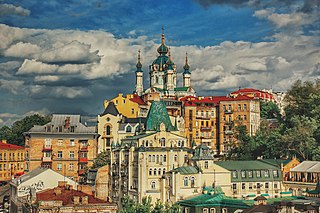
Andriivskyi Descent or Andrew's Descent is a historic descent connecting Kyiv's Upper Town neighborhood and the historically commercial Podil neighborhood. The street, often advertised by tour guides and operators as the "Montmartre of Kyiv", is a major tourist attraction of the city. It is included in the list of national landmarks by the government resolution. In addition, the street is also part of the Kyiv city historic reserve "Ancient Kyiv", while the St. Andrew's Church belongs to the National historic reserve "Sophia of Kyiv".

House with Chimaeras or Horodetsky House is an Art Nouveau building located in the historic Lypky neighborhood of Kyiv, the capital of Ukraine. Situated across the street from the President of Ukraine's office at No. 10, Bankova Street, the building has been used as a presidential residence for official and diplomatic ceremonies since 2005. The street in front of the building is closed off to all automobile traffic, and is now a patrolled pedestrian zone due to its proximity to the Presidential Administration building.

Kyiv National Ivan Karpovych Karpenko-Karyi Theatre, Cinema and Television University is the national university specializing exclusively in performing arts and located in Kyiv, Ukraine. It is a multidisciplinary institution that includes a department of theatrical arts and the Institute of Screen Arts. The university has four campuses around the city of Kyiv and a separate student dormitory. The acting rector of the university is Inna Kocharian.

The Military Institute of Telecommunication and Information Technologies named after the Heroes of Kruty is an institution of higher military education in Ukraine and part of the State University of Telecommunications, located in Pechersk neighborhood of Kyiv. In the Soviet times it was known as the Kyiv Military Engineering College of Signal.
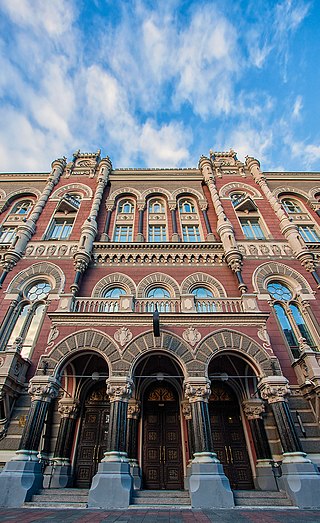
The National Bank of Ukraine building serves as the headquarters for the National Bank of Ukraine, located in the country's capital Kyiv. The building is located in the city's Pechersk district, which houses several other prominent Ukrainian government offices.
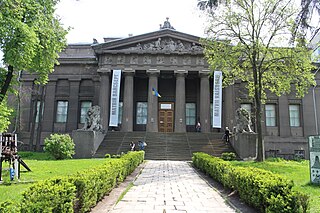
The National Art Museum of Ukraine is a museum dedicated to Ukrainian art in Kyiv, Ukraine.

The Ukrainian National Tchaikovsky Academy of Music, formerly Kyiv Conservatory, is a national music tertiary academy in Kyiv, Ukraine. Its courses include postgraduate education.
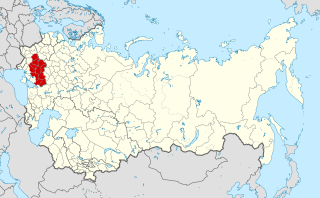
The Kiev Military District was a military district of the Imperial Russian Army and subsequently of the Red Army and Soviet Armed Forces. It was first formed in 1862, and was headquartered in Kiev (Kyiv) for most of its existence.

Volhynia Governorate, also known as Volyn Governorate, was an administrative-territorial unit (guberniya) of the Southwestern Krai of the Russian Empire. It consisted of an area of 71,736 square kilometres (27,697 sq mi) and a population of 2,989,482 inhabitants. The governorate bordered Grodno and Minsk Governorates to the north, Kiev Governorate to the east, Podolia Governorate to the south, Lublin and Siedlce Governorates, and after 1912, Kholm Governorate and Austria to the west. Its capital was in Novograd-Volynsky until 1804, and then Zhitomir. It corresponded to most of modern-day Volyn, Rivne and Zhytomyr Oblasts of Ukraine and some parts of Brest and Gomel Regions of Belarus.

Kiev Governorate was an administrative-territorial unit (guberniya) of the Russian Empire from 1796 to 1919 and the Ukrainian Soviet Socialist Republic from 1919 to 1925. It included the territory of the right-bank Ukraine and was formed after a division of the Kiev Viceroyalty into Kiev and Little Russia Governorates in 1796. Its capital was in Kiev. By the early 20th century, it consisted of 12 uyezds, 12 cities, 111 miasteczkos and 7344 other settlements. After the October Revolution, it became part of the administrative division of the Ukrainian SSR. In 1923 it was divided into several okrugs and on 6 June 1925 it was abolished by the Soviet administrative reforms.

The Ukrainian People's Republic of Soviets was a short-lived (1917–1918) Soviet republic of the Russian SFSR that was created by the declaration of the Kharkiv All-Ukrainian Congress of Soviets "About the self-determination of Ukraine" on 25 December [O.S. 12 December] 1917 in the Noble Assembly building in Kharkov. Headed by the Provisional Workers' and Peasants' Government of Ukraine formed earlier in Russian Kursk. The republic was later united into the Ukrainian Soviet Republic and, eventually, liquidated, because of a cessation of support from the government of the Russian SFSR when the Treaty of Brest-Litovsk was signed.
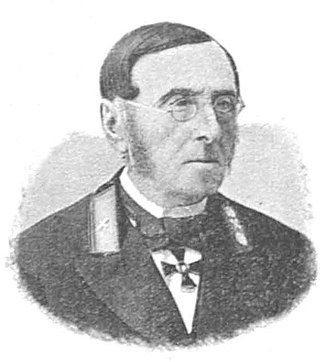
Mikhail Stepanovich Ikonnikov was a Kyiv Guberniya architect, once famous among Kyiv city residents.

Ivan Ustinovich Kharchenko was a Soviet Army Military engineering Colonel and Hero of the Soviet Union. During World War II, he was a platoon commander. Kharchenko was promoted to the rank of Junior lieutenant in 1939, lieutenant in 1943 and senior lieutenant in 1944. He reportedly personally defused more than 50,000 explosives, including bombs, mines, and shells. For his actions in defusing explosives, Kharchenko was named a Hero of the Soviet Union and awarded the Gold Star and Order of Lenin on 2 November 1944. In the citation for the Hero of the Soviet Union award, it was stated that Kharchenko personally defused more than 1500 bombs weighing more than 500 kilograms each and 25,000 other explosive objects. After World War II, Kharchenko continued his military service until retirement in 1964. Until 1956 he was personally engaged in rendering innocuous explosive items left over from World War II.

The Ivan Bohun Military High School is an educational military institution located in Kyiv, Ukraine.

Volodymyrska Street is a street in the center of Kyiv, the capital of Ukraine, which is named after the prince of Kievan Rus' Vladimir the Great and which is one of the oldest streets in the city, and arguably among the oldest constantly inhabited residential street in Europe. There are many educational, culture and government institutions on this street, as well as historical monuments. Four buildings from Volodymyrska Street are depicted on reverses of Ukrainian hryvnia banknotes.
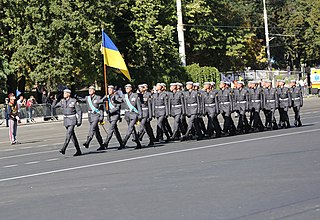
The Odesa Military Academy is a modern higher military institution of the inter-services Armed Forces of Ukraine. The academy conducts language training for servicemen and employees of the Armed Forces of Ukraine, advanced training of military personnel and scientific and pedagogical workers, and the preparation of students in the training of reserve officers.